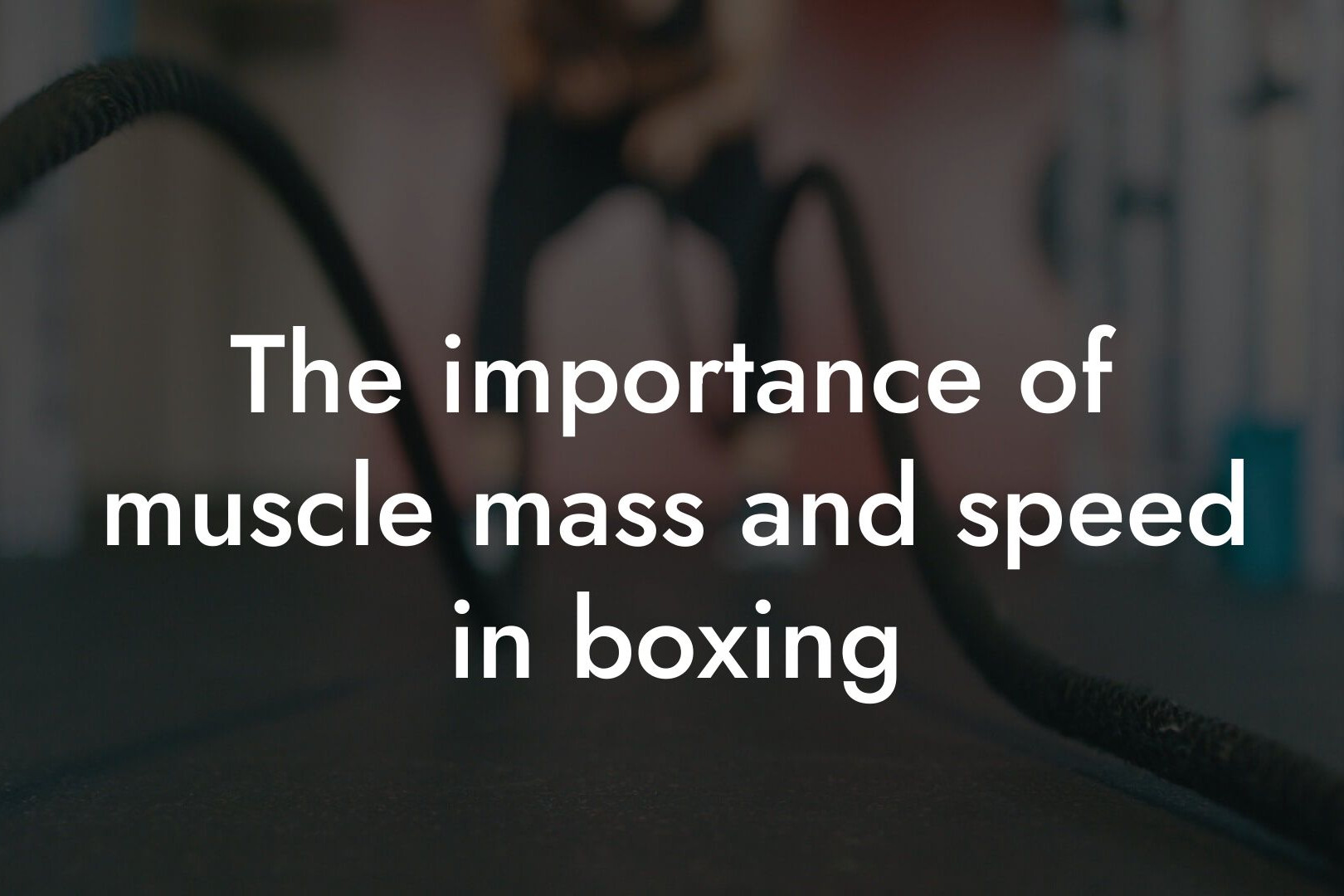As an amateur boxer, it's essential to have a well-structured strength and conditioning program to improve your performance, increase your endurance, and reduce the risk of injury. A comprehensive program will help you build the necessary strength, power, speed, and agility to excel in the ring. In this article, we'll provide you with a detailed guide on how to create an effective strength and conditioning program tailored to your needs as an amateur boxer.
Table of Contents
- Understanding the Demands of Boxing
- Components of a Strength and Conditioning Program for Amateur Boxers
- Strength Training for Amateur Boxers
- Conditioning Training for Amateur Boxers
- Plyometric Training for Amateur Boxers
- Flexibility and Mobility Training for Amateur Boxers
- Periodization and Programming for Amateur Boxers
- Frequently Asked Questions
Understanding the Demands of Boxing
Boxing is a high-intensity sport that requires a unique combination of strength, power, speed, agility, and endurance. A typical boxing match consists of 3-minute rounds with 1-minute rest periods in between. During each round, you'll need to explosively generate force, quickly change direction, and maintain a high level of intensity over an extended period. To meet these demands, your strength and conditioning program should focus on developing the following physical attributes:
- Maximal strength: The ability to generate maximum force in a short period.
- Power: The ability to rapidly generate force.
- Speed: The ability to quickly move around the ring and throw punches.
- Agility: The ability to quickly change direction and evade your opponent's punches.
- Endurance: The ability to maintain a high level of intensity over an extended period.
Components of a Strength and Conditioning Program for Amateur Boxers
A comprehensive strength and conditioning program for amateur boxers should include the following components:
- Strength training: Focuses on building maximal strength, power, and muscle endurance.
- Conditioning training: Focuses on improving cardiovascular endurance, speed, and agility.
- Plyometric training: Focuses on developing explosive power.
- Flexibility and mobility training: Focuses on improving range of motion and reducing the risk of injury.
- Functional training: Focuses on exercises that mimic the movements and actions of boxing.
Strength Training for Amateur Boxers
A strength training program for amateur boxers should focus on exercises that improve maximal strength, power, and muscle endurance. Some effective exercises for boxers include:
- Squats: Develops strength and power in the legs.
- Deadlifts: Develops strength and power in the legs, glutes, and back.
- Bench press: Develops strength and power in the chest, shoulders, and triceps.
- Rows: Develops strength and power in the back and biceps.
- Shoulder press: Develops strength and power in the shoulders.
- Core exercises: Develops strength and endurance in the core muscles.
Conditioning Training for Amateur Boxers
A conditioning training program for amateur boxers should focus on exercises that improve cardiovascular endurance, speed, and agility. Some effective exercises for boxers include:
- High-intensity interval training (HIIT): Improves cardiovascular endurance and speed.
- Pro agility shuttle: Improves speed and agility.
- Box jumps: Improves explosive power and speed.
- Resistance band training: Improves strength and endurance in the upper body.
- Medicine ball training: Improves core strength and endurance.
Plyometric Training for Amateur Boxers
A plyometric training program for amateur boxers should focus on exercises that develop explosive power. Some effective exercises for boxers include:
- Box jumps: Develops explosive power in the legs.
- Depth jumps: Develops explosive power in the legs and improves landing mechanics.
- Medicine ball throws: Develops explosive power in the upper body.
- Plyometric push-ups: Develops explosive power in the chest, shoulders, and triceps.
Flexibility and Mobility Training for Amateur Boxers
A flexibility and mobility training program for amateur boxers should focus on exercises that improve range of motion and reduce the risk of injury. Some effective exercises for boxers include:
- Static stretching: Improves range of motion and reduces muscle tension.
- Dynamic stretching: Improves range of motion and prepares the muscles for explosive movements.
- Mobility exercises: Improves joint mobility and reduces the risk of injury.
Periodization and Programming for Amateur Boxers
A well-structured strength and conditioning program for amateur boxers should include a periodized approach to training. This involves alternating between periods of intense training and periods of active recovery. A typical periodized program may include:
- Macrocycle: A long-term training phase that lasts several months.
- Mesocycle: A medium-term training phase that lasts several weeks.
- Microcycle: A short-term training phase that lasts several days.
In conclusion, a well-structured strength and conditioning program is essential for amateur boxers who want to improve their performance, increase their endurance, and reduce the risk of injury. By incorporating the components outlined in this article, you'll be able to develop a comprehensive program that meets the unique demands of boxing. Remember to periodize your training, focus on functional exercises, and incorporate a combination of strength, conditioning, plyometric, and flexibility training to take your boxing skills to the next level.
At Tano Performance Group, we understand the importance of a well-structured strength and conditioning program for amateur boxers. Our team of experts can help you develop a personalized program that meets your specific needs and goals. Contact us today to learn more about our services and how we can help you achieve your goals in the ring.
Frequently Asked Questions
What is strength and conditioning, and how does it benefit amateur boxers?
Strength and conditioning is a type of training that focuses on improving an individual's overall physical fitness and athleticism. For amateur boxers, a well-structured strength and conditioning program can enhance their performance, increase their endurance, and reduce their risk of injury. By incorporating exercises that target specific muscle groups, amateur boxers can improve their punching power, speed, agility, and overall fighting ability.
What are the key components of a strength and conditioning program for amateur boxers?
A comprehensive strength and conditioning program for amateur boxers should include a combination of exercises that target strength, power, speed, agility, endurance, and flexibility. This may include weightlifting, plyometric exercises, cardio exercises, and functional training that mimics the movements and actions required in boxing.
How often should I train for strength and conditioning as an amateur boxer?
The frequency of strength and conditioning training for amateur boxers will depend on their individual goals, experience level, and training phase. Generally, it's recommended to train 2-3 times per week, with at least one day of rest in between. As you get closer to a competition, you may need to increase the frequency and intensity of your training.
What are some common strength exercises for amateur boxers?
Some common strength exercises for amateur boxers include squats, deadlifts, bench press, rows, and lunges. These exercises target multiple muscle groups, including the legs, core, and upper body, which are essential for generating power and speed in boxing.
How can I improve my power and speed as an amateur boxer?
To improve power and speed as an amateur boxer, you can incorporate explosive exercises such as box jumps, depth jumps, and medicine ball throws into your training program. You can also focus on building your core strength, as a strong core is essential for generating power and speed in boxing.
What is plyometric training, and how can it benefit amateur boxers?
Plyometric training, also known as jump training, involves explosive movements that help improve power, speed, and agility. For amateur boxers, plyometric training can help improve their punching power, speed, and overall fighting ability. Examples of plyometric exercises include box jumps, depth jumps, and burpees.
How can I improve my endurance as an amateur boxer?
To improve endurance as an amateur boxer, you can incorporate cardio exercises such as running, cycling, or swimming into your training program. You can also focus on building your anaerobic endurance through high-intensity interval training (HIIT) and strength training exercises.
What is functional training, and how can it benefit amateur boxers?
Functional training involves exercises that mimic the movements and actions required in boxing. For amateur boxers, functional training can help improve their fighting technique, increase their endurance, and reduce their risk of injury. Examples of functional training exercises include bag work, pad work, and defensive drills.
How can I incorporate strength and conditioning into my boxing training?
To incorporate strength and conditioning into your boxing training, you can start by dedicating 2-3 days per week to strength and conditioning exercises. You can also incorporate strength and conditioning exercises into your boxing training sessions, such as doing a strength circuit before or after your boxing training.
What are some common mistakes amateur boxers make when it comes to strength and conditioning?
Some common mistakes amateur boxers make when it comes to strength and conditioning include not incorporating enough variety into their training program, not focusing on functional exercises, and not listening to their bodies and taking rest days when needed.
How can I measure my progress and track my results as an amateur boxer?
To measure your progress and track your results as an amateur boxer, you can use a variety of metrics, including your punching power, speed, agility, endurance, and overall fighting ability. You can also track your progress through metrics such as your body fat percentage, bone density, and overall physique.
What is periodization, and how can it benefit amateur boxers?
Periodization involves dividing your training program into specific phases or periods, each with a specific goal or focus. For amateur boxers, periodization can help them peak at the right time, reduce their risk of injury, and improve their overall performance.
How can I stay motivated and avoid burnout as an amateur boxer?
To stay motivated and avoid burnout as an amateur boxer, you can set specific goals for yourself, both short-term and long-term. You can also vary your training program to avoid boredom and prevent plateaus. Additionally, taking rest days and listening to your body can help you avoid burnout and stay motivated.
What is the importance of proper nutrition and recovery for amateur boxers?
Proper nutrition and recovery are essential for amateur boxers, as they help support muscle growth, repair, and recovery. A well-balanced diet that includes plenty of protein, complex carbohydrates, and healthy fats can help amateur boxers optimize their performance and reduce their risk of injury.
How can I incorporate nutrition and recovery into my strength and conditioning program?
To incorporate nutrition and recovery into your strength and conditioning program, you can start by fueling your body with a well-balanced diet that includes plenty of protein, complex carbohydrates, and healthy fats. You can also prioritize rest and recovery, including getting enough sleep, stretching, and foam rolling.
What are some common injuries that amateur boxers experience, and how can strength and conditioning help prevent them?
Some common injuries that amateur boxers experience include hand and wrist injuries, shoulder injuries, and head injuries. Strength and conditioning can help prevent these injuries by improving muscle strength, endurance, and flexibility, as well as enhancing overall athleticism and fighting ability.
How can I modify my strength and conditioning program if I'm injured or experiencing pain?
If you're injured or experiencing pain, you can modify your strength and conditioning program by reducing the intensity and volume of your training, or by focusing on exercises that don't exacerbate the injury. You can also work with a trainer or coach to develop a rehabilitation program that helps you recover from your injury.
What are some common misconceptions about strength and conditioning for amateur boxers?
Some common misconceptions about strength and conditioning for amateur boxers include the idea that strength training will make you slow or bulky, or that cardio exercises are the only way to improve endurance. However, a well-structured strength and conditioning program can actually improve speed, agility, and endurance, while also reducing the risk of injury.
How can I find a qualified trainer or coach to help me with my strength and conditioning program?
To find a qualified trainer or coach to help you with your strength and conditioning program, you can start by asking for referrals from other boxers or trainers. You can also research online, or look for trainers who have experience working with boxers and have a certification in strength and conditioning.
What are some online resources that can help me with my strength and conditioning program?
There are many online resources that can help you with your strength and conditioning program, including websites, blogs, and social media channels that provide training tips, exercises, and workout routines. You can also find online training programs and coaching services that can help you develop a customized strength and conditioning program.
How can I stay consistent and motivated with my strength and conditioning program over time?
To stay consistent and motivated with your strength and conditioning program over time, you can set specific goals for yourself, both short-term and long-term. You can also vary your training program to avoid boredom and prevent plateaus, and find a training partner or accountability partner to help keep you motivated.
Here are some related articles you might love...
- The importance of muscle mass and speed in boxing
- Bone density and injury prevention in boxing
- Balancing power, speed, and endurance in boxing
- Reducing body fat for optimal weight class in boxing
- Nutrition tips for maintaining energy and muscle in boxing
- How body composition affects performance in boxing
- Off-season training for amateur boxers
- Recovery strategies for boxers after sparring sessions
- The role of DEXA scans in boxing training and weight management
Zak Faulkner
Zak Faulkner is a leading authority in the realm of physical health and body composition analysis, with over 15 years of experience helping professionals optimise their fitness and well-being. As one the experts behind Tano Performance Group, Zak has dedicated his career to providing in-depth, science-backed insights that empower clients to elevate their physical performance and overall health.
With extensive knowledge of DEXA technology, Zak specializes in delivering comprehensive body assessments that offer precise data on body fat, muscle mass, bone density, and overall physique. His expertise enables individuals to make informed decisions and achieve their fitness goals with accuracy and confidence. Zak’s approach is rooted in a deep understanding of human physiology, combined with a passion for helping clients unlock their full potential through personalised strategies.
Over the years, Zak has earned a reputation for his commitment to excellence, precision, and client-focused service. His guidance is trusted by top professionals who demand the best when it comes to their health. Whether advising on fitness programs, nutritional strategies, or long-term wellness plans, Zak Faulkner’s insights are a valuable resource for anyone serious about taking their health and fitness to the next level.
At Tano Performance Group, Zak continues to lead our Content Team revolutionising how professionals approach their physical health, offering unparalleled expertise that drives real results.




